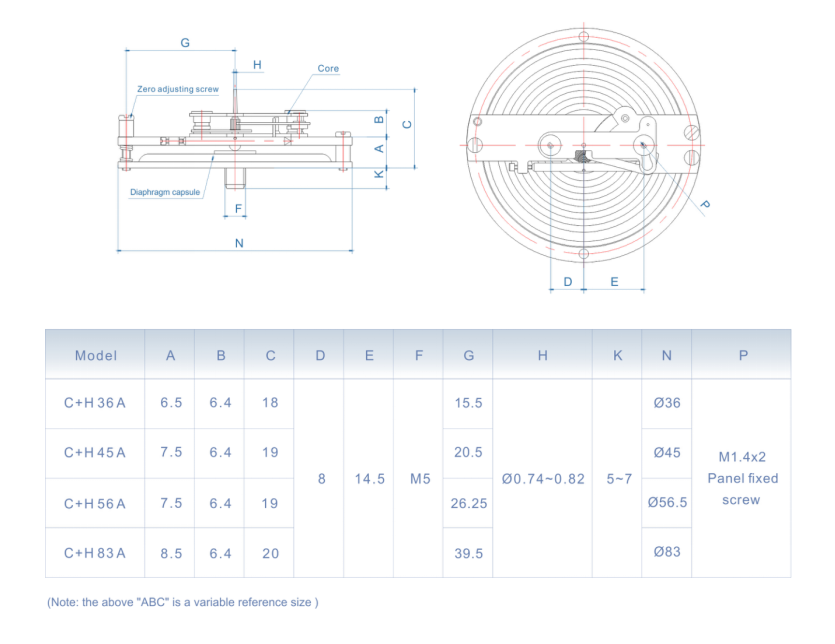
Nov . 04, 2024 19:58 Back to list
diaphragm material pressure gauge jah
Understanding Diaphragm Material in Pressure Gauges A Deep Dive into Design and Performance
Pressure gauges are essential instruments used in various industries to measure the pressure of gases and liquids. Among the many components that contribute to the effectiveness and accuracy of these instruments, the diaphragm material plays a pivotal role. This article explores the significance of diaphragm materials in pressure gauges, with particular emphasis on their properties, selection criteria, and performance implications.
What is a Diaphragm in a Pressure Gauge?
A diaphragm in a pressure gauge is a flexible membrane that separates the pressure-sensing element from the medium whose pressure is being measured. When pressure is applied, the diaphragm deforms, moving a pointer or an electronic sensor to provide a reading. The choice of diaphragm material is crucial, as it significantly influences the accuracy, durability, and application range of the pressure gauge.
Common Diaphragm Materials
1. Stainless Steel Stainless steel is one of the most widely used materials for diaphragms, owing to its excellent corrosion resistance, strength, and durability. It performs well in high-pressure applications and can withstand a wide range of temperatures. Stainless steel diaphragms are commonly used in oil and gas, petrochemical, and aerospace industries.
2. Bronze and Brass These materials are used in gauges that measure lower pressures. They offer good machinability and resistance to rust and corrosion. However, their performance may be limited in highly corrosive environments or at elevated temperatures.
3. Polymers For applications involving aggressive chemicals or where metal compatibility is an issue, polymer diaphragms are often the best choice. Materials like PTFE (Teflon), rubber, and other elastomers provide excellent chemical resistance and can accommodate various media without fear of contamination.
4. Silicone and Neoprene These elastomeric materials have excellent flexibility and can be used in applications that require elastic response to pressure changes. They are particularly useful in low-pressure applications and environments where vibration or pulsation is a concern.
Selection Criteria for Diaphragm Materials
When selecting a diaphragm material for a pressure gauge, several factors should be considered
diaphragm material pressure gauge jah

1. Chemical Compatibility The diaphragm must resist degradation from the medium being measured. Understanding the chemical properties of the fluid or gas is critical to avoid material failure.
2. Temperature and Pressure Range The chosen material should withstand the anticipated pressure levels and temperature fluctuations without compromising performance.
3. Mechanical Properties Flexibility, strength, and fatigue resistance are essential characteristics that determine how well a diaphragm will perform over time, especially in dynamic applications.
4. Cost Depending on the application, the cost of materials can vary significantly. Balancing performance needs with budget constraints is crucial in the decision-making process.
5. Certification and Compliance In many industries, pressure gauges must meet specific regulatory standards and certifications. Ensuring that materials used in the diaphragm comply with these standards is important for safety and reliability.
Impact on Gauge Performance
The material of the diaphragm directly affects the performance of the pressure gauge. A well-chosen diaphragm material enhances the gauge's accuracy and responsiveness. For instance, stainless steel diaphragms provide a robust response under varying pressure conditions, ensuring that readings are reliable over time. In contrast, polymer diaphragms might exhibit slight hysteresis but excel in corrosive environments.
Moreover, the diaphragm's design and material influence the gauge's longevity. A durable material will resist wear and tear, minimizing maintenance needs and downtime in industrial applications.
Conclusion
The diaphragm material in pressure gauges is more than just a technical specification; it influences the performance, reliability, and applicability of the gauge across various settings. As industries continue to demand higher precision and resilience in their instrumentation, the materials selected for diaphragms will play a critical role in advancing pressure measurement technology. By carefully considering the properties of diaphragm materials, manufacturers can design pressure gauges that meet the increasingly complex demands of modern applications. Understanding these dynamics is essential for engineers and technicians who rely on pressure measurement for safe and efficient operations.
-
Precision Differential Pressure Gauge Factory Custom Solutions & OEM Services
NewsMay.27,2025
-
Pressure Diaphragm Capsule Elements High-Accuracy & Durable Solutions
NewsMay.27,2025
-
WIKA Pressure Gauge Accessories Custom Solutions & Quotes
NewsMay.26,2025
-
Medical Air Pressure Gauges Precision & Certified Solutions
NewsMay.26,2025
-
Fluke Differential Pressure Gauges Precision Instruments for Industrial Use
NewsMay.25,2025
-
WIKA Differential Pressure Gauge 700.01 - High Accuracy & Durable Design
NewsMay.25,2025
